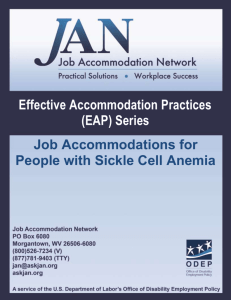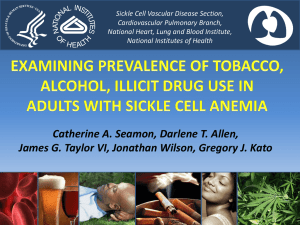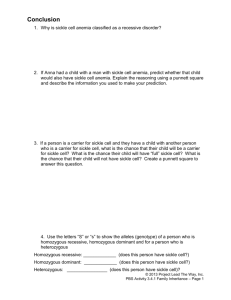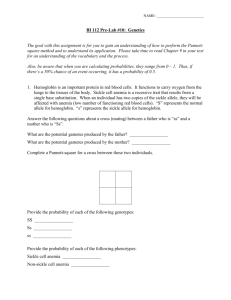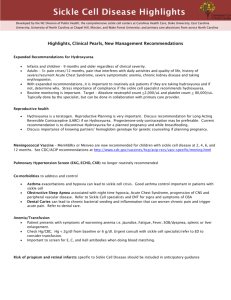Accommodations for People with Sickle Cell Anemia
advertisement
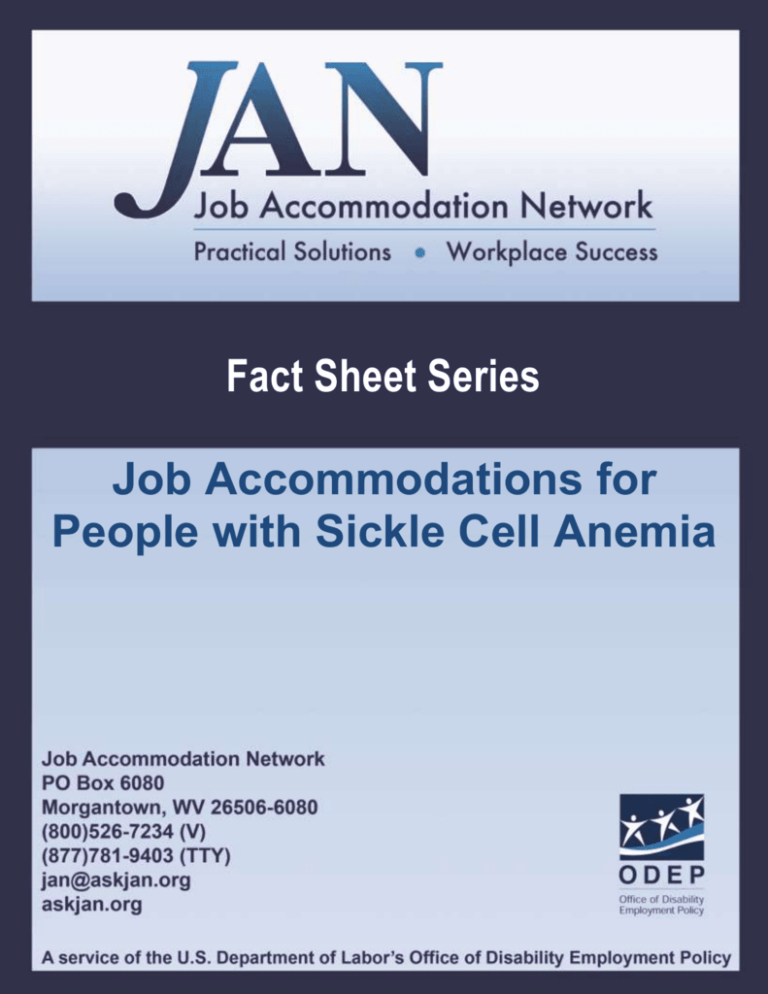
Fact Sheet Series Job Accommodations for People with Sickle Cell Anemia JAN’S ACCOMMODATION FACT SHEET SERIES JOB ACCOMMODATIONS FOR PEOPLE WITH SICKLE CELL ANEMIA Sickle cell anemia, or sickle cell disease, is a genetically inherited blood disorder that affects the shape of red blood cells. Red blood cells are normally round, smooth, and soft, which allows them to move easily through the blood system. In sickle cell disease, blood cells are crescent, or sickle-shaped, and rigid. This is due to blood cells that contain an abnormal type of hemoglobin. The abnormal shape of red blood cells prevents the cells from properly moving through blood vessels and carrying oxygen to all parts of the body. The sickle-shaped blood cells die sooner than ordinary blood cells, which results in significantly fewer red blood cells and causes anemia. People with sickle cell disease experience chronic anemia and periodic episodes of pain, sometimes referred to as “crisis.” When the sickle-shaped blood cells block the flow of blood and oxygen to the limbs and organs of the body, severe pain and damage to tissues and organs can result. People can experience pain episodes affecting the arms, legs, chest, and abdomen; damage to the lungs, spleen, kidneys, and liver, among other organs; have a stroke; and develop acute chest syndrome and bacterial infections. Symptoms can range from mild to very severe. According to the National Institutes of Health, sickle cell disease is the most common inherited blood disorder in the United States, affecting over 70,000 Americans. The disease is a lifelong, chronic condition. Sickle cell disease and its symptoms can be treated, but for most people there is no cure. People with sickle cell disease often require prophylactic antibiotics, folic acid supplementation, pain management, intravenous fluids, and frequent blood transfusions. Blood transfusions reduce recurrent pain crises, the risk of stroke, and other complications. The following is an overview of some of the accommodations that might be useful for employees with sickle cell anemia. For a more in depth discussion, access JAN's publications at http://askjan.org/media/atoz.htm. To discuss an accommodation situation with a consultant, contact JAN directly. Recurrent Need for Medical Intervention or Transfusions: Allow flexible scheduling Allow time off for medical appointments Allow work from home full-time, part-time, or as needed Provide additional unpaid leave if employee exhausts accrued time off Permit a family member or friend to call-off for person when in “crisis” 4 Fatigue/Weakness: Reduce or eliminate physical exertion and workplace stress Schedule periodic rest breaks away from the workstation Allow a flexible work schedule and flexible use of leave time Allow work from home Implement ergonomic workstation design Move workstation close to other work areas, office equipment, and break rooms Provide a scooter or other mobility aid if walking cannot be reduced Provide an accessible parking space Disease Maintenance: Schedule steady shifts Reduce or eliminate physical exertion and workplace stress Allow fluids at workstation to stay hydrated Permit time off or a flexible schedule for exercise Avoid temperature extremes Allow the use of a heating pad for pain management Respiratory Difficulties and Reduced Immunity: Provide adjustable ventilation and avoid temperature extremes Keep work environment free from dust, smoke, odors, and fumes Provide an air cleaner Keep work environment clean and hygienic Provide anti-bacterial wipes to clean workstations Implement an illness policy, requiring employees to stay home if contagious to avoid exposing co-workers to colds, flu, etc. Stress: Develop strategies to deal with work problems before they arise Reduce or eliminate workplace stress Provide sensitivity training to coworkers Allow telephone calls during work hours to doctors and others for support Provide information on counseling and employee assistance programs Temperature Sensitivity: Modify work-site temperature or provide an office with separate temperature control Modify dress code and use fan/air-conditioner or heater at the workstation Allow work from home during extremely hot or cold weather Redirect air-conditioning and heating vents 5 Resources Specifically for People with Sickle Cell Anemia American Sickle Cell Anemia Association 10300 Carnegie Avenue Cleveland, Ohio 44106 Direct: (216) 229-8600 http://www.ascaa.org/ National Heart, Lung, and Blood Institute National Institutes of Health (NIH) P.O. Box 30105 Bethesda, MD 20824-0105 Direct: (301) 592-8573 TTY: (240) 629-3255 nhlbiinfo@nhlbi.nih.gov http://www.nhlbi.nih.gov Sickle Cell Disease Association of America, Inc. 231 East Baltimore Street, Suite 800 Baltimore, Maryland 21202 Toll free: (800) 421-8453 Direct: (410) 528-1555 scdaa@sicklecelldisease.org http://www.sicklecelldisease.org Sickle Cell Information Center PO Box 109, Grady Memorial Hospital 80 Jessie Hill Jr. Drive SE Atlanta, GA 30303 Direct: (404) 616-3572 aplatt@emory.edu http://www.scinfo.org/ U.S. National Library of Medicine Genetics Home Reference Sickle Cell Disease http://ghr.nlm.nih.gov/condition=sicklecelldisease Updated 3/23/10. 4 This document was developed by the Job Accommodation Network, funded by a contract agreement from the U.S. Department of Labor, Office of Disability Employment Policy (DOL079RP20426). The opinions expressed herein do not necessarily reflect the position or policy of the U.S. Department of Labor. Nor does mention of trade names, commercial products, or organizations imply endorsement by the U.S. Department of Labor. 5
